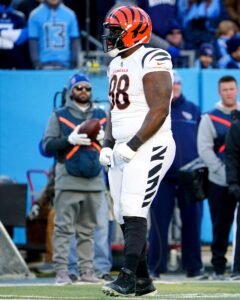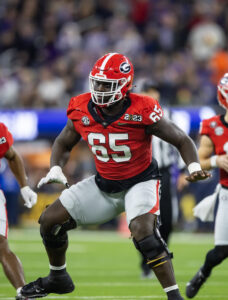Joe Burrow’s health was a talking point leading into the 2023 campaign as he dealt with a calf strain. That ailment gave way to a season-ending elbow injury midway through the year, one which added to his missed time and hindered the Bengals’ playoff push.
Cincinnati still managed a 9-8 record, but it was insufficient for a wild-card berth. The team identified improvements in the secondary as a priority, although changes on the other side of the ball have proven to be a key factor in the past few months as well. Alterations along the offensive line and at the skill positions (more of which are likely on hand next offseason) have left the Bengals with several new faces to integrate as Burrow and Co. prepare to navigate another long list of AFC contenders.
Trades:
- Dealt RB Joe Mixon to Texans for 2024 seventh-round pick
Mixon’s Bengals future was in question last offseason, with his cap figure being weighed against the prospect of a transition to a younger setup in the backfield. Team and player reached agreement on a restructure during which the 27-year-old took a notable pay cut. Before a 2024 roster bonus was due, Cincinnati elected to move forward with a Mixon release. 
The team ended up reversing course, though, with Houston taking on the veteran as a new lead back. The Texans showed heavy interest in making a backfield addition representing an upgrade over Devin Singletary, including a lucrative Saquon Barkley offer. Tony Pollard and D’Andre Swift were also on the team’s radar, but Mixon will carry the load for at least the short-term future.
Mixon, who became the third-leading rusher in Bengals history last season, agreed to a two-year, $19.75MM extension upon arrival in Houston. As a result of that agreement (which includes $13MM in guarantees), the Oklahoma product is under contract through 2026 to begin the second phase of his career. The Texans’ offense features plenty of pass-catching options, but Mixon should be a factor in his new team’s bid to repeat the success of 2023.
For the Bengals, life after the former second-rounder will mark a notable change in the backfield. In each of his healthy seasons since 2018, Mixon logged no fewer than 210 carries, topping 1,200 scrimmage yards during each of those campaigns. Cincinnati will have a much more cost-efficient running back setup moving forward, but the team’s production in the ground game will face question marks.
Free agency additions:
- Sheldon Rankins, DT. Two years, $24.5MM ($8MM guaranteed)
- Geno Stone, S. Two years, $14MM ($6MM guaranteed)
- Zack Moss, RB. Two years, $8MM ($3MM guaranteed)
- Trent Brown, T. One year, $4.75MM ($2MM guaranteed)
- Mike Gesicki, TE. One year, $2.5MM ($400K guaranteed)
- Vonn Bell, S. One year, $1.2MM
- Logan Woodside, QB. One year, $1.13MM
 With respect to PFR’s top 50 free agent list, the Bengals withstood many more losses than additions this spring. Rankins is nevertheless a notable new face along the defensive interior. The 30-year-old delivered a strong showing during his one-and-done Texans campaign, racking up six sacks. That figure represented his highest total since 2018 and included a three-sack performance against Cincinnati. He will be counted on to deliver an impact in the pass-rush department as a central member on the team’s new-look defensive line.
With respect to PFR’s top 50 free agent list, the Bengals withstood many more losses than additions this spring. Rankins is nevertheless a notable new face along the defensive interior. The 30-year-old delivered a strong showing during his one-and-done Texans campaign, racking up six sacks. That figure represented his highest total since 2018 and included a three-sack performance against Cincinnati. He will be counted on to deliver an impact in the pass-rush department as a central member on the team’s new-look defensive line.
Rankins received an offer averaging $12MM per year from the Texans before deciding to join the Bengals. The former Saints first-rounder logged a consistent workload during his Jets stint (2021-22), and his uptick in production in Houston will lead to high expectations on his fourth career team. Pairing Trey Hendrickson with a dependable interior rush contributor could help a defense which ranked 17th in sacks last season. Cincinnati struggled against the run in 2023, though, and the team’s new faces up front will play a key role in determining if improvement takes place.
The Bengals finished mid-pack through the air in 2023 despite Burrow’s missed time. Their largest issue on offense was the ground game (90 rushing yards per contest, 31st in the league). With Mixon no longer in the picture, increased attention will be paid to Chase Brown in addition to Moss moving forward. The latter operated in a rotational capacity during the start of his career, but the midseason 2022 trade which moved him from the Bills to the Colts resulted in an uptick in playing time. 
For two different stretches last season, Moss operated as Indianapolis’ lead back. The 26-year-old received double-digit carries eight times in 2023, and his 183 total attempts were comfortably the most of his career. Undersized at 5-9, the 205-pounder will be tasked with operating between the tackles for Cincinnati to complement Chase’s speed. Moss did not receive as lucrative of a deal as many other free agent backs this offseason, but his addition could prove to be a highly cost-effective one if he translates his Colts success to his new home.
Entering the offseason, Cincinnati planned to make a short-term addition at right tackle while also seeking out a more permanent solution at the position via the draft. That approach led to a Mekhi Becton visit prior to the Brown signing. Like he did during his first Patriots stint, Brown manned the blindside over the past two seasons upon returning to New England. The 31-year-old blocker struggled in 2022 but when healthy last season, he rebounded in terms of PFF evaluation (80.2 overall grade). He also has experience at the right tackle spot he will play with the Bengals.
 Brown’s deal contains incentives (just as his Patriots pacts did), so his play in Cincinnati will carry financial implications. With Burrow’s health remaining a top organizational priority, pass protection at both tackle spots will continue to be an area of scrutiny for the Bengals. Brown’s long-term replacement may very well be in the organization, but the 10th-year veteran could provide an experienced option during at least the start of the campaign.
Brown’s deal contains incentives (just as his Patriots pacts did), so his play in Cincinnati will carry financial implications. With Burrow’s health remaining a top organizational priority, pass protection at both tackle spots will continue to be an area of scrutiny for the Bengals. Brown’s long-term replacement may very well be in the organization, but the 10th-year veteran could provide an experienced option during at least the start of the campaign.
After breakdowns in the secondary became a consistent problem for the 2023 Bengals, it came as no surprise that additions at the safety spot were deemed a priority. Stone, 25, established himself as a strong special-teamer early in his Baltimore career, but he took on a much larger defensive workload this past season. The former seventh-rounder logged an 82% snap share and translated that into an AFC-leading seven interceptions and nine pass deflections. A repeat of that ball production would certainly be welcomed in a Jessie Bates-less defensive backfield.
Bell landed a three-year Panthers deal last offseason, but after a single campaign with the team he was released in a cost-shedding move. That paved the way for an inexpensive return to Cincinnati, one which could see him reprise his former starting role. With recent first-rounder Dax Hill transitioning from safety to corner, the play of Stone and Bell on the backend will go a long way in determining how much the Bengals rebound from 2023’s struggles against the pass.
Re-signings:
- Drew Sample, TE. Three years, $10.5MM ($3.5MM guaranteed)
- Akeem Davis-Gaither, LB. One year, $2.74MM ($676K guaranteed)
- Trenton Irwin, WR. One year, $1.5MM ($250K guaranteed)
- Cody Ford, OL. One year, $1.35MM ($175K guaranteed)
- Tanner Hudson, TE. One year, $1.29MM ($168K guaranteed)
- Joe Bachie, LB. One year, $1.28MM ($75K guaranteed)
- Trayveon Williams, RB. One year, $1.29MM
- Cal Adomitis, LS. One year, $985K
- Devin Cochran, T. One year, $795K
 Taking a flier on Gesicki will give the Bengals a new look at tight end from a pass-catching standpoint, but the team will continue to depend on familiar faces at the position. Sample has not come close to matching his playing time or production from 2020, but he has remained a staple in Cincinnati’s offense in the years since. The 28-year-old also contributes on special teams, and third-phase responsibilities will no doubt continue moving forward as Hudson looks to once again serve as a complementary receiving target.
Taking a flier on Gesicki will give the Bengals a new look at tight end from a pass-catching standpoint, but the team will continue to depend on familiar faces at the position. Sample has not come close to matching his playing time or production from 2020, but he has remained a staple in Cincinnati’s offense in the years since. The 28-year-old also contributes on special teams, and third-phase responsibilities will no doubt continue moving forward as Hudson looks to once again serve as a complementary receiving target.
The same holds true for Irwin, who has spent his entire five-year career in Cincinnati. The former UDFA scored four touchdowns on only 15 receptions in 2022, and he followed that up with personal bests in receptions (25) and yards (316) last season. He could take another step forward in 2024 and in doing so provide the Bengals with cost-effective production in the passing game. Considering the team’s current (and future) financial situation at the receiver spot, effective depth will be critical.
Notable losses:
- Chidobe Awuzie, CB
- Markus Bailey, LB
- Tyler Boyd, WR
- A.J. McCarron, QB (released)
- D.J. Reader, DT
- Max Scharping, OL
- Nick Scott, S (released)
- Irv Smith Jr., TE
- Josh Tupou, DT
- Mitchell Wilcox, TE
- Jonah Williams, T
Once the Bengals added Orlando Brown Jr. in free agency last offseason, the writing seemed to be on the wall for Williams. The former first-rounder rescinded a trade request and accepted a right tackle assignment for 2023, once again serving as a full-time starter. Williams underwhelmed in terms of PFF evaluation (for the second year in a row), which no doubt hurt his market value and hindered his chances of finding a left tackle gig with a new team.
 The 26-year-old nevertheless secured $30MM on a two-year Cardinals deal. Arizona will move Paris Johnson Jr. to the blind side in 2024, a transition which comes as little surprise considering his pedigree and college experience. That will leave Williams to continue handling right tackle responsibilities in his new home while the Bengals move in a different direction
The 26-year-old nevertheless secured $30MM on a two-year Cardinals deal. Arizona will move Paris Johnson Jr. to the blind side in 2024, a transition which comes as little surprise considering his pedigree and college experience. That will leave Williams to continue handling right tackle responsibilities in his new home while the Bengals move in a different direction
Reader’s torn quad – the second of his career – ended his Bengals tenure and threatened to reduce his market value. Cincinnati hoped to keep its four-year DT starter in the fold, but it soon became clear he would at least explore other opportunities. The 30-year-old enjoyed a consistent spell in Cincinnati (when healthy), proving his $53MM Bengals pact to be a solid investment on the team’s part.
To little surprise, Reader was unable to match that figure on his third career contract. His Lions visit ultimately yielded a two-year deal, but its maximum value ($27.25MM) only includes $7.4MM guaranteed at signing. The former fifth-rounder’s health and performance in Detroit will determine whether or not he remains with the Lions for 2025. Likewise, uncertainty surrounds the veteran and rookie additions the Bengals brought in to replace him.
With Ja’Marr Chase and Tee Higgins both in need of new deals, it became clear entering the 2023 season that Boyd’s next contract would likely come from a new team. Upon hitting the market, several teams were listed as suitors. One of those was his hometown Steelers, with which a mutual interest existed for working out an agreement. The Steelers were not willing to increase the value of the initial offer made to the Pittsburgh native, though, steering Boyd in a new direction.
 The eight-year veteran took several visits and eventually inked a one-year Titans deal. Boyd, 29, will have plenty of competitions for targets on a team which also features DeAndre Hopkins and Calvin Ridley at the receiver spot. That setup is not unlike what he would have experienced had he remained in Cincinnati, and Will Levis is certainly not as accomplished as Burrow. Nonetheless, Boyd’s 2025 market will come down to his ability to perform under a familiar face in Brian Callahan.
The eight-year veteran took several visits and eventually inked a one-year Titans deal. Boyd, 29, will have plenty of competitions for targets on a team which also features DeAndre Hopkins and Calvin Ridley at the receiver spot. That setup is not unlike what he would have experienced had he remained in Cincinnati, and Will Levis is certainly not as accomplished as Burrow. Nonetheless, Boyd’s 2025 market will come down to his ability to perform under a familiar face in Brian Callahan.
Awuzie was a key figure on the Bengals’ defense during their Super Bowl run, but his 2022 ACL tear hurt his subsequent performances. He found himself out of the lineup midway through last season and despite returning to first-team duties afterwards, the former Cowboy was not expected to be retained in free agency.
Also taking a Cincinnati-to-Tennessee pathway, Awuzie landed nearly $23MM guaranteed on a three-year pact. He will be counted on as a full-time starter with the Titans while the Bengals rely on recent draftees to replace him. Upon switching to corner, Hill will spend the summer competing with DJ Turner for a starting spot. The winner of that battle will join fellow recent second-round selection Cam Taylor-Britt in a revamped Cincinnati secondary.
Draft:
- Round 1, No. 18: Amarius Mims (T, Georgia)
- Round 2, No. 49: Kris Jenkins Jr. (DT, Michigan) (signed)
- Round 3, No. 80: Jermaine Burton, WR (Alabama) (signed)
- Round 3, No. 97: McKinnley Jackson (DT, Texas A&M) (signed)
- Round 4, No. 115: Erick All (TE, Iowa) (signed)
- Round 5, No. 149: Josh Newton (CB, TCU) (signed)
- Round 6, No. 194: Tanner McLachlan (TE, Arizona) (signed)
- Round 6, No. 214: Cedric Johnson (DE, Ole Miss) (signed)
- Round 7, No. 224 (from Cardinals through Texans): Daijahn Anthony (DB, Mississippi State) (signed)
- Round 7, No. 237: Matt Lee (C, Miami) (signed)
With Brown being added on a one-year deal, right tackle remained a central priority leading into the draft. To no surprise, then, Cincinnati was connected to a number of prospects at the top of a celebrated class. JC Latham was firmly on the team’s radar, although the Alabama product established himself as the second-best O-lineman and went to the Titans at No. 7. 
Likewise, the Bengals hosted both Taliese Fuaga and Troy Fautanu on pre-draft visits while evaluating their Day 1 options. The former excelled at right tackle with Oregon State, but the Saints added him with the intention of trying him on the blind side. That is also the case for the latter, whom Cincinnati will see plenty of for years to come during his Steelers tenure. When facing a decision between Fautanu and Mims, the Bengals chose to invest in upside over track record.
Fautanu played a key role on an offense which journeyed to the national title game, although he enters the league with questions related to health and the arm length needed to hold up at tackle. Mims certainly represents a gamble in his own respect based on a severe lack of playing time at Georgia. He made just eight starts in college. Starts in the 2022 playoffs set up a starting right tackle gig this past season, but an ankle injury limited his availability prior to declaring.
That decision proved to be a sound one as his frame (6-foot-7, 340 pounds) and athletic upside still resulted in a top-20 selection. Mims’ size and traits could lead to success on the right side early on and even allow him to transition to the left side down the road. Considering Mims’ inexperience, Cincinnati would no doubt prefer a redshirt rookie season to acclimate to the NFL — if Brown makes such a path possible.
 Jenkins made only one appearance during his freshman campaign, but over the past three seasons he was an impactful member of the Wolverines’ elite defense. The second-generation NFL D-lineman’s best season as a run defender came in 2022 (54 stops), but during the team’s undefeated run to the title he set new career highs in sacks (2.5) and tackles for loss (4.5). That led to second-team all-conference and All-American honors and as such high expectations at the NFL level.
Jenkins made only one appearance during his freshman campaign, but over the past three seasons he was an impactful member of the Wolverines’ elite defense. The second-generation NFL D-lineman’s best season as a run defender came in 2022 (54 stops), but during the team’s undefeated run to the title he set new career highs in sacks (2.5) and tackles for loss (4.5). That led to second-team all-conference and All-American honors and as such high expectations at the NFL level.
Considering the addition of Rankins in free agency (and with B.J. Hill still under contract for 2024), neither Jenkins nor Jackson should be forced into a heavy workload right away. The latter spent four seasons with the Aggies, increasing his sack total with every passing campaign. He added 15.5 tackles for loss during his college career. Translating that disruptiveness to the pro game will allow him to carve out at least a rotational role along the interior.
Burton spent two years each at Georgia and Alabama, establishing himself as a deep threat with both programs. The relocating SEC talent’s 18 yards per catch average and 22 touchdowns illustrate his big-play ability, although character concerns are present as well upon entry into the NFL. The 6-foot, 196-pounder is one of several contenders for the third receiver spot vacated by Boyd, so his training camp and preseason performances will be interesting to see.
Extensions and restructures:
- Signed C Ted Karras to one-year, $6MM extension
- Signed QB Jake Browning to two-year, $1.95MM extension
Karras was part of the Bengals’ 2022 efforts to shore up their offensive line, and he has served in a starting role throughout his Cincinnati tenure. The 31-year-old was set to see his contract expire following the 2024 campaign, but his play to date earned him a bump in compensation and an extra year of security. 
Karras will average $6.6MM across the next two seasons, a figure which could prove to be cost-effective if he remains a consistent performer. The former Patriot and Dolphin hopes to finish his career in Cincinnati, and his chances of doing so have increased.
Browning was tendered as an exclusive rights free agent, but cases such as his often result in separate extensions being worked out. The former UDFA would have been on course for restricted free agency in 2025, but his multi-year deal will prevent that from happening. Browning, 28, took over for Burrow after he was lost to injury and led the league in completion percentage (70.4%).
That total was not accompanied by a strong touchdown-to-interception ratio (12:7), but team and player will hope the near future will not include an extended run of opportunities to improve upon it. Browning’s presence will give the Bengals notable continuity at multiple spots on the QB depth chart.
Other:
- WR Tee Higgins signed $21.82MM franchise tag
- Exercised WR Ja’Marr Chase’s 2025 fifth-year option ($21.82MM)
- OC Brian Callahan took Titans’ head coaching gig
- Promoted QBs coach Dan Pitcher to offensive coordinator
- Turned down DE Trey Hendrickson‘s trade request
- Hired Justin Rascati as pass-game coordinator
- Colt Anderson joined Titans as special teams coordinator
- Signed 14 UDFAs
 The expected outcome in Higgins’ case played out with 2024 set up as a walk year. The 25-year-old requested a trade in March with signs continuing to point to no extension agreement being reached, and Chase is known to be a higher priority for the Bengals. Cincinnati remained steadfast in wanting to keep Higgins in place for the coming season, though, so no serious consideration was made for moving him.
The expected outcome in Higgins’ case played out with 2024 set up as a walk year. The 25-year-old requested a trade in March with signs continuing to point to no extension agreement being reached, and Chase is known to be a higher priority for the Bengals. Cincinnati remained steadfast in wanting to keep Higgins in place for the coming season, though, so no serious consideration was made for moving him.
Higgins seemed to admit that when publicly addressing his future. Talks on a long-term deal have not taken place recently, and a new round of negotiations (especially without Chase having an extension in hand) would come as a notable surprise.
With Higgins tied to the tag — the only member of this year’s nine-man tag contingent not extended by the July 15 deadline — no talks can commence until January. The Bengals have not been prepared to submit a Higgins offer averaging more than $20MM per season; presuming the Bengals continue this recent negotiating pattern with their No. 2 wideout, a departure next offseason should be considered likely.
The top of the receiver market experienced another wave this offseason, and Higgins stands to benefit from a new pecking order in the relatively near future. He topped 900 yards as a rookie, then recorded back-to-back campaigns with 1,000-plus after Chase’s arrival. Rebounding from an injury-shortened 2023 season would allow Higgins to further his case for serving as a true No. 1 option on a new team. Meeting that goal is feasible, but almost certainly certainly not in Cincinnati after this year.
The Bengals are not known for spending big on the open market or with respect to retaining homegrown players. A rather expensive (but obvious) exception came last offseason with Burrow landing $55MM per season – coupled with significant cashflow early on and over $145MM locked in at signing. A similar commitment (relative to positional value, of course) will be needed to keep Chase in the fold.
 Reuniting with his former LSU quarterback has allowed Chase to live up to expectations and stake his claim as one of the league’s top wideouts at any age. The 24-year-old has earned a Pro Bowl nod during each of his three seasons, racking up 3,717 yards and 29 touchdowns in that span. To little surprise, Chase’s camp waited for Justin Jefferson to reset the receiver market (via a $35MM-per-year extension with monster guarantees) before allowing serious talks for his own deal to take place.
Reuniting with his former LSU quarterback has allowed Chase to live up to expectations and stake his claim as one of the league’s top wideouts at any age. The 24-year-old has earned a Pro Bowl nod during each of his three seasons, racking up 3,717 yards and 29 touchdowns in that span. To little surprise, Chase’s camp waited for Justin Jefferson to reset the receiver market (via a $35MM-per-year extension with monster guarantees) before allowing serious talks for his own deal to take place.
A number of receivers looking for new deals skipped voluntary OTAs this spring, Chase included. Cincy’s top weapon did, however, take part in mandatory minicamp, a sign he may be willing to attend training camp even if no agreement is worked out by that point. Jefferson’s deal offers a potential blueprint for a Chase extension, and CeeDee Lamb could provide another comparable example if he and the Cowboys finalize an agreement of their own. Plenty of time remains for team and player to find a resolution in Chase’s case, but it will remain a storyline if none emerges before the start of the year.
Head coach Zac Taylor has been in place since 2019, and he had enjoyed notable stability at both the offensive and defensive coordinator spots until this offseason. DC Lou Anarumo is going into his sixth season with the Bengals, but Callahan’s departure will be felt on offense. Taylor will continue calling plays for the unit, meaning expectations will remain high and a drop-off would come as a surprise. Still, Cincinnati’s play design and preparation on the offensive side of the ball will undergo changes in a season when a deep postseason run remains a distinct possibility.
Callahan was on the head coaching track prior to this year, and he had second interviews lined up with the Panthers and Falcons prior to his Titans hire. While his departure thus came as little surprise, the same was true when Pitcher was tapped as Callahan’s replacement. The former took outside interviews, but Cincinnati only met with one other candidate before tapping him for the gig. Pitcher’s Bengals tenure dates back to 2016, so his transition to the role should be relatively smooth. 
Hendrickson, 29, and the Bengals worked out a short-term arrangement last offseason, one which upped his 2023 earnings and added a year to his pact. His 2024 and 2025 salaries are nonguaranteed, though, which explains his decision to approach the team prior to the draft in search of new assurances. None were given, and Taylor confirmed in April the team’s stance that no consideration would be given to a trade.
The three-time Pro Bowler appears to be on board with suiting up in 2024 even if no adjustment is made to his pact. Hendrickson has been as advertised (perhaps better) in terms of production since joining Cincinnati, racking up 39.5 sacks across three campaigns. Expectations will remain high for the standout pass rusher moving forward, although it will be interesting to see if he makes a final push for a raise and/or new guarantees before the start of the regular season.
Top 10 cap charges for 2024:
- Joe Burrow, QB: $29.55MM
- Tee Higgins, WR: $21.82MM
- Trey Hendrickson, DE: $20.17MM
- Orlando Brown Jr., LT: $16.4MM
- Sheldon Rankins, DT: $11.94MM
- B.J. Hill, DT: $10.83MM
- Sam Hubbard, DE: $10.12MM
- Ja’Marr Chase, WR: $9.81MM
- Alex Cappa, G: $9.25MM
- Logan Wilson, LB: $9.05MM
Burrow’s market-topping deal will play a central role in Cincinnati’s financial decisions for years to come. The same will, of course, be true at the receiver position once Chase’s extension is in place. Even without an adjustment to his contract, Hendrickson ranks ninth in the league amongst edge rusher cap hits, a sign of his standing around the league at the position. Hill is the only player on the list other than Higgins who is a pending free agent, so stability at a number of key positions should be expected in 2025.
After Burrow’s latest major injury, he and the Bengals took a new approach to his recovery during the spring. Remaining healthy during the fall and through the postseason received added emphasis at the expense of returning to full health months before the start of the campaign, a strategy with which Burrow is fully on board.
If it succeeds, Cincinnati will once again be a team to be taken seriously in the AFC North and Super Bowl LIX races. A number of teams in the conference have made intriguing additions at the quarterback spot in recent years, and the AFC North figures to remain arguably the most competitive division in the league. Questions will loom over Higgins’ future and the effects his departure would have on the Bengals’ offense in 2025; for now, though, that unit (and the team as a whole) should enter the fall with aspirations of another run to the Super Bowl.
Man, that’s one crowded TE room.
Solid 11 win team
Everything hinges on Burrow’s staying healthy and fans have reasonable doubts about that happening.
Love Burrow. He has that mental toughness and determination to finish drives and win games, unlike Tua and Dak. They’ll be a tough out in the playoffs.
Burrow has 7 game winning drives in 52 career starts (13%). Both Tua and Dak have a better percentage than that.
Burrow doesn’t need game winning drives. Tua and Dak do! For arguments sake, you’d take Tua or Dak over Burrow? I wouldn’t.